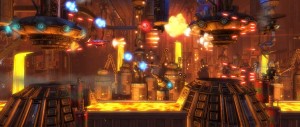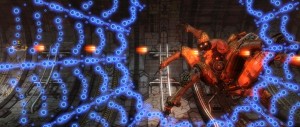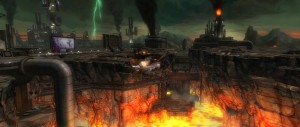Presentation: 10
Replayability: 7
Overall Score: 9
Sine Mora is a modern 2.5D (2D plane of movement, but rendered in 3D) side-scrolling shoot ‘em up with the heart of a classic. If you are a fan of old-school games like Gradius, R-Type, orDarius, you will certainly feel at home with the fairly simple gameplay mechanics, frantic dodging action, and the huge mega-bosses that permeate the seas and skies of Sine Mora. The game has been co-developed by both Digital Reality (Sky Drift, Dead Block) and Grasshopper Manufacture, (No More Heroes 2: Desperate Struggle, Chainsaw Lollipop) and is being published by Microsoft exclusively for Xbox Live Arcade.
Starting the game, there are several game modes to choose from. You can opt to play Story, Arcade, or Score Attack. Playing Story mode is, predictably, the way you unlock all the characters and ships. That’s where most of the presentation is held with it’s story sequences, prologue chapter, and threaded pilot banter. Story mode also houses the two easiest game settings, Normal and Challenging. Arcade mode ramps up the difficulty with more and tougher enemies, limits your life (here represented as a time limit) to only a few seconds, and also cuts out all of the story bits that you’ve probably seen too many times if you’re willing to jump into this difficulty level. There are two difficulty levels here, Hard and Insane, the latter boasts “FOR THE MANIAKKU OR SUPERPLAY ATTEMPTS ONLY!” It is true, this mode is soul-crushingly hard. Score Attack allows you to play a single level through over and over again, rising in rank on the leaderboards until you are satisfied with your score, then you may move onto any other level you wish to improve upon. This mode also has the Hard and Insane difficulty levels, like Arcade mode.
The action itself is some heart-pounding, side-scrolling stuff. Your ship can take a few hits, but you don’t have a life-meter as much as you do a time-limit. Displayed prominently at the top-centre of the screen, this time-limit can be increased by killing enemies and collecting certain power-ups as you progress and depletes as time wears on into the level. This tends to keep you in the action as you will want to constantly be killing enemies rather than sweeping around them to avoid their fire. There are no breaks in any of the modes other than story, where presentation plays a much bigger role in the game progression.
 Your ship has three kinds of weapons. Your basic A-button fire, a secondary weapon, and a time-manipulation device. The basic pea-shooter is auto-fire (you can simply hold A to fire, rather than tapping the button repeatedly) and upgradable in 9 steps. The tutorial at the beginning calls these upgrades “permanent” but the power-ups tend to fall out of your ship when you get hit, making them very difficult to hold on to. Imagine you’ve been collecting power-ups for a while and you have just acquired your 7th-step, you come to a particularly hazardous bit of the level and the screen is suddenly filled with projectiles, one of them grazes you and all of your hard-earned power-ups go flying out the nose of your ship. Since this bit is particularly hairy, you dare not sweep across the screen to try and collect them and they all fly off-screen. What you are left with is what amounts to a squirt gun, ineffective and unimpressive. This promotes a feeling of transience in the level of your basic firepower, how very un-permanent. Since the enemies have a true life-meter and take at least a couple hits to take down with the bottom-tier basic weapon, and since killing enemies is how power-ups appear on the screen, it becomes increasingly difficult to acquire power-ups as your machinegun lowers its step.
Your ship has three kinds of weapons. Your basic A-button fire, a secondary weapon, and a time-manipulation device. The basic pea-shooter is auto-fire (you can simply hold A to fire, rather than tapping the button repeatedly) and upgradable in 9 steps. The tutorial at the beginning calls these upgrades “permanent” but the power-ups tend to fall out of your ship when you get hit, making them very difficult to hold on to. Imagine you’ve been collecting power-ups for a while and you have just acquired your 7th-step, you come to a particularly hazardous bit of the level and the screen is suddenly filled with projectiles, one of them grazes you and all of your hard-earned power-ups go flying out the nose of your ship. Since this bit is particularly hairy, you dare not sweep across the screen to try and collect them and they all fly off-screen. What you are left with is what amounts to a squirt gun, ineffective and unimpressive. This promotes a feeling of transience in the level of your basic firepower, how very un-permanent. Since the enemies have a true life-meter and take at least a couple hits to take down with the bottom-tier basic weapon, and since killing enemies is how power-ups appear on the screen, it becomes increasingly difficult to acquire power-ups as your machinegun lowers its step.
The secondary fire is dependent on which pilot is flying your ship, each pilot has a different form of secondary fire that they prefer, so there is a little flavour in weapon selection that other similar games are lacking. In Story mode the current pilot is a predetermined value, but in Arcade and Score Attack, you can choose which pilot you’d like to have in the seat. The weapons are anything from basic seeker missiles to splash-damage bombs and some more exotic weaponry. They are generally standard fare, I nearly always choose the seeker missile to help me garner more time when I’m running low.
The time-manipulation devices are one of the main features in this game. When I first heard about this game, I thought that it would be like Braid where you need to puzzle out which things to do at the same time and use a time looping function to achieve that goal. I was disappointed with the final choices the developers made for these devices. They don’t play nearly as much of a role as I thought they would, and, while there is a time-reversal device, none of the devices are utilized as a puzzle mechanic. Indeed, there are no puzzley bits at all in this game. That might be my fault for expecting something different from what, to other people, probably looks like a very standard side-scrolling shooter, but I feel like they missed something that could have made this game stand out, wave their arms, and scream “Look at me! I’m something you’ve never seen before!” At any rate, the manipulation devices range from the aforementioned time-reversal (even after you explode in a firey ball,) to speed-up (which makes everything else look as if it is moving slowly, a huge help for getting out of tight spots,) and even bullet-reflection. Don’t ask me how bullet-reflection is a time-manipulation device, this is not exactly hard sci-fi here. The device that you select before entering a stage is displayed with your other stats on the upper right-hand portion of the screen. Interestingly enough, this gauge appears as a little tube filled with blue, rather than a group of units. This means that you can use your device exactly as much or as sparingly as you choose.
The large multi-part, often multi-screen bosses are impressive and very deadly. Once you’ve played through on Story  mode and are ready for the Arcade experience, you will fight these bosses over and over again before bringing them down at these higher difficulties. Example: A seemingly impossible-to-avoid lasers that sweeps the screen, depleting your time and killing you instantly can be avoided by flying right up to the optic lens and remaining a constant half centimeter above it as is cleanses the rest of the screen in holy fire. This took me three tries to figure out and another two to actually execute the maneuver in the time between realizing that the enemy is about to shoot and when it actually does. Once I got this technique down, the boss was actually fairly easy. There are numerous patterns for all of the bosses in the game, and as a player you will likewise be trying again and again to figure out that pattern and execute it so that the bosses can be taken down.
mode and are ready for the Arcade experience, you will fight these bosses over and over again before bringing them down at these higher difficulties. Example: A seemingly impossible-to-avoid lasers that sweeps the screen, depleting your time and killing you instantly can be avoided by flying right up to the optic lens and remaining a constant half centimeter above it as is cleanses the rest of the screen in holy fire. This took me three tries to figure out and another two to actually execute the maneuver in the time between realizing that the enemy is about to shoot and when it actually does. Once I got this technique down, the boss was actually fairly easy. There are numerous patterns for all of the bosses in the game, and as a player you will likewise be trying again and again to figure out that pattern and execute it so that the bosses can be taken down.
 mode and are ready for the Arcade experience, you will fight these bosses over and over again before bringing them down at these higher difficulties. Example: A seemingly impossible-to-avoid lasers that sweeps the screen, depleting your time and killing you instantly can be avoided by flying right up to the optic lens and remaining a constant half centimeter above it as is cleanses the rest of the screen in holy fire. This took me three tries to figure out and another two to actually execute the maneuver in the time between realizing that the enemy is about to shoot and when it actually does. Once I got this technique down, the boss was actually fairly easy. There are numerous patterns for all of the bosses in the game, and as a player you will likewise be trying again and again to figure out that pattern and execute it so that the bosses can be taken down.
mode and are ready for the Arcade experience, you will fight these bosses over and over again before bringing them down at these higher difficulties. Example: A seemingly impossible-to-avoid lasers that sweeps the screen, depleting your time and killing you instantly can be avoided by flying right up to the optic lens and remaining a constant half centimeter above it as is cleanses the rest of the screen in holy fire. This took me three tries to figure out and another two to actually execute the maneuver in the time between realizing that the enemy is about to shoot and when it actually does. Once I got this technique down, the boss was actually fairly easy. There are numerous patterns for all of the bosses in the game, and as a player you will likewise be trying again and again to figure out that pattern and execute it so that the bosses can be taken down.
One interesting and very useful function is the addition of a Boss Practice mode, which can be selected at the mode selection screen after you have defeated and unlocked the first boss of the game. This allows you to hone your skills for the boss battles without actually having to go through the entire level to do so. I can think of a few games which would have benefited greatly from this function. (The entire Mega Man series, I’m looking at you.)
One major gripe that I have with this game is that you can’t reconfigure the buttons. Under the “Local Capabilities” heading in the description of the game on XBLA, is states specifically that arcade joysticks are supported. Now, let’s disregard the fact that arcade joysticks are supported in ANY game which uses the D-pad in the same way that it uses the left analog (for movement.) That leaves us with either a convenient button arrangement for use on the arcade stick or input reprogramability to make it work. This game has neither of those things, meaning that when using my HORI arcade stick, the active buttons are spread out over the face button in a very awkward and clunky way. To clarify, what it does have is three control schemes. These schemes may or may not work with whichever arcade stick you currently have, so I will list them here so that you can compare them with your stick layout.
Type A – Primary Fire=A, Secondary Fire=B, Time Capsule=RT
Type B – Primary Fire=A, Secondary Fire=X, Time Capsule=Y
Type C – Primary Fire=A, Secondary Fire=B, Time Capsule=X
The story is told by way of both narrated text at the beginning of each level, and also pilot banter. The opening level narrative is entirely voiced in what sounds like Russian to me, but the text is in English. There is a distinct lack of feeling in each of these sequences. Having the Russian voice-acting seems too melodramatic a move for so flat a delivery, and I find myself skipping over these sequences quite often. On the other hand, the pilot banter sequences are quite good. They are full of character and feeling, you can feel the hatred when one pilot sincerely wishes death on another pilot with whom they are trying to pull off a mission. The character interaction is well written and executed, making for some messed up emotional reactions on the player’s part when you realize, for example, that the pilot you are currently utilizing is blackmailing another into working for him. I ended up rooting for one particular side of that tension, even though I needed to wield all the pilots to their utmost capacity in play.
The timeline in the earlier levels is a little bit convoluted as you play several different points of view that take place simultaneously through the missions. The pilots have strong personalities and are well-characterized, so playing some of them is bonding, and certain stages are memorable, not only for the gameplay and boss battles, but for achieving a goal that the pilots have set for themselves. The dialogue is used as a benchmark as you hear the same clips of conversation before and after communication is broken with some characters and then established with others, introducing new characters and new facets to the increasingly emotionally complicated story of wartime ethics and morality. Unfortunately, during the middle levels, the story is put on the backburner as dialogue doesn’t amount to much more than “I’ll kill you, you giant hunk of metal!” Which leaves us with only he aforementioned flat Russian narratives at the beginnings of each level. In the end, I ended up confused, not because the story was badly written, but because the ethics involved were confusing and I ended up never touching certain pilots in arcade mode because I truly didn’t like their character.
 The graphic design is advertised as Diesel-Punk. I don’t know precisely what that means, but it ends up looking like a WW2-era cross between 1942 (the game,) Metropolis, James Cameron’s Avatar (more in the jungle level),Dark Cloud 2, and Last Exile. The game is completely epic in scale and everything big looks, sounds, and feels big. Small things are hard to hit and everything is just impossibly heavy. Deadly, poisonous insects must be navigated around or shot down, huge war Zeppelins fill the sky, floating cities with dubious yet hauntingly beautiful underbellies become the playing field for epic struggles for domination and liberty.
The graphic design is advertised as Diesel-Punk. I don’t know precisely what that means, but it ends up looking like a WW2-era cross between 1942 (the game,) Metropolis, James Cameron’s Avatar (more in the jungle level),Dark Cloud 2, and Last Exile. The game is completely epic in scale and everything big looks, sounds, and feels big. Small things are hard to hit and everything is just impossibly heavy. Deadly, poisonous insects must be navigated around or shot down, huge war Zeppelins fill the sky, floating cities with dubious yet hauntingly beautiful underbellies become the playing field for epic struggles for domination and liberty.
The characters are Furries. I’m not going to beat around this too much, they are Anthromorphs. The females are designed to look sexy and the males are designed to be hulks. I am not a lover of Anthromorphs utilized in games, but I don’t have a strong aversion to them either. I can forgive the game this slight transgression because the rest of the game is so good. I didn’t mind the cast of StarFox either, since the game was solid and even boundary-pushing for its time, the same holds true here. If you can’t stand Furries in your video games, then I wouldn’t recommend this game to you. If you either don’t mind or love Anthromorphs, these ones are well drawn and characterized. The characters are worthy of the names and personalities they are given.
The music was designed by none other than Akira Yamaoka (Silent Hill, Shadows of the Damned) so be prepared for some eerie delay in the atmospheric noise and piano so soft that it sounds as if the instrument is made of feathers. There are some creepy off-key parts which honestly send chills up my spine in remembrance of older survival horror experiences. A+ music for sure.
If you’re looking for a solid arcade experience, deep characters, and an amazing presentation and find a few extra pesos in your pocket, buy Sine Mora. If you came for Braid-style, genre-shattering, time-manipulation-based puzzle gameplay, take another look at what makes up the core of this game before purchasing, though I still recommend it to everyone with a 360.
No comments:
Post a Comment